Capella University: Disaster Recovery Plan for Health Disparities
VerifiedAdded on 2022/08/20
|12
|1164
|14
Project
AI Summary
This disaster recovery plan addresses the challenges faced by the Valley City Fire Department during a simulated disaster, highlighting issues in communication, chain of command, hospital staffing, and water supply contamination. The plan emphasizes the aim of disaster management, which is to reduce casualties, provide timely assistance, and ensure swift recovery. It outlines the disaster management cycle, including mitigation, preparedness, response, and recovery phases, with examples of actions at each stage. The plan stresses the importance of social justice and cultural sensitivity in emergency response, focusing on providing immediate assistance and meeting the basic needs of victims. It also discusses the impact of government policies on disaster recovery, referencing the NAEMSP's recommendations for EMS involvement. Evidence-based strategies to overcome barriers like gaps in faith, language, and culture are included, along with recommended solutions such as fostering relationships between response workers and researchers. The plan emphasizes the importance of community stakeholder approval and improved communication for effective implementation of evidence-based policies.
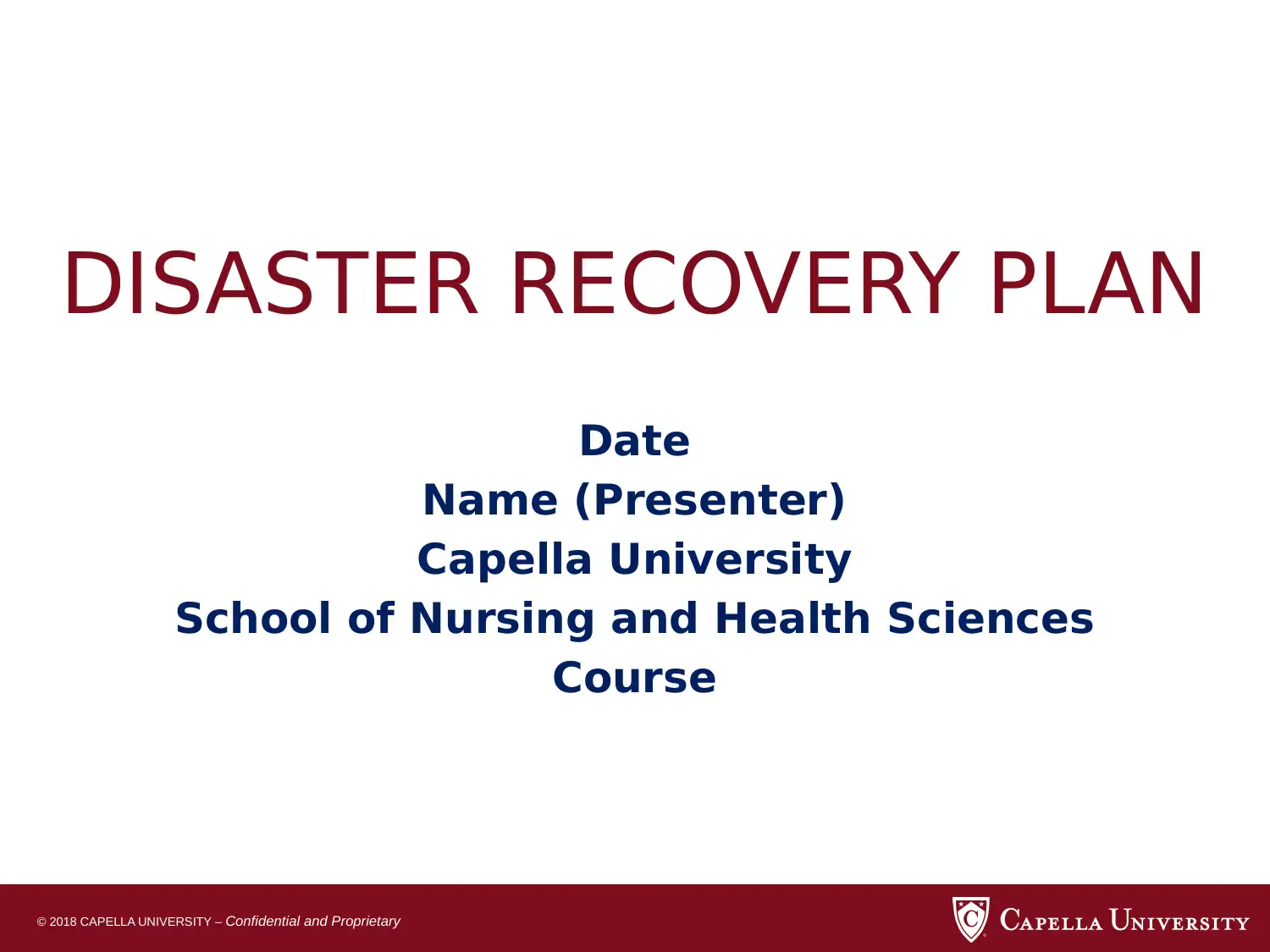
© 2018 CAPELLA UNIVERSITY – Confidential and Proprietary
DISASTER RECOVERY PLAN
Date
Name (Presenter)
Capella University
School of Nursing and Health Sciences
Course
DISASTER RECOVERY PLAN
Date
Name (Presenter)
Capella University
School of Nursing and Health Sciences
Course
Paraphrase This Document
Need a fresh take? Get an instant paraphrase of this document with our AI Paraphraser
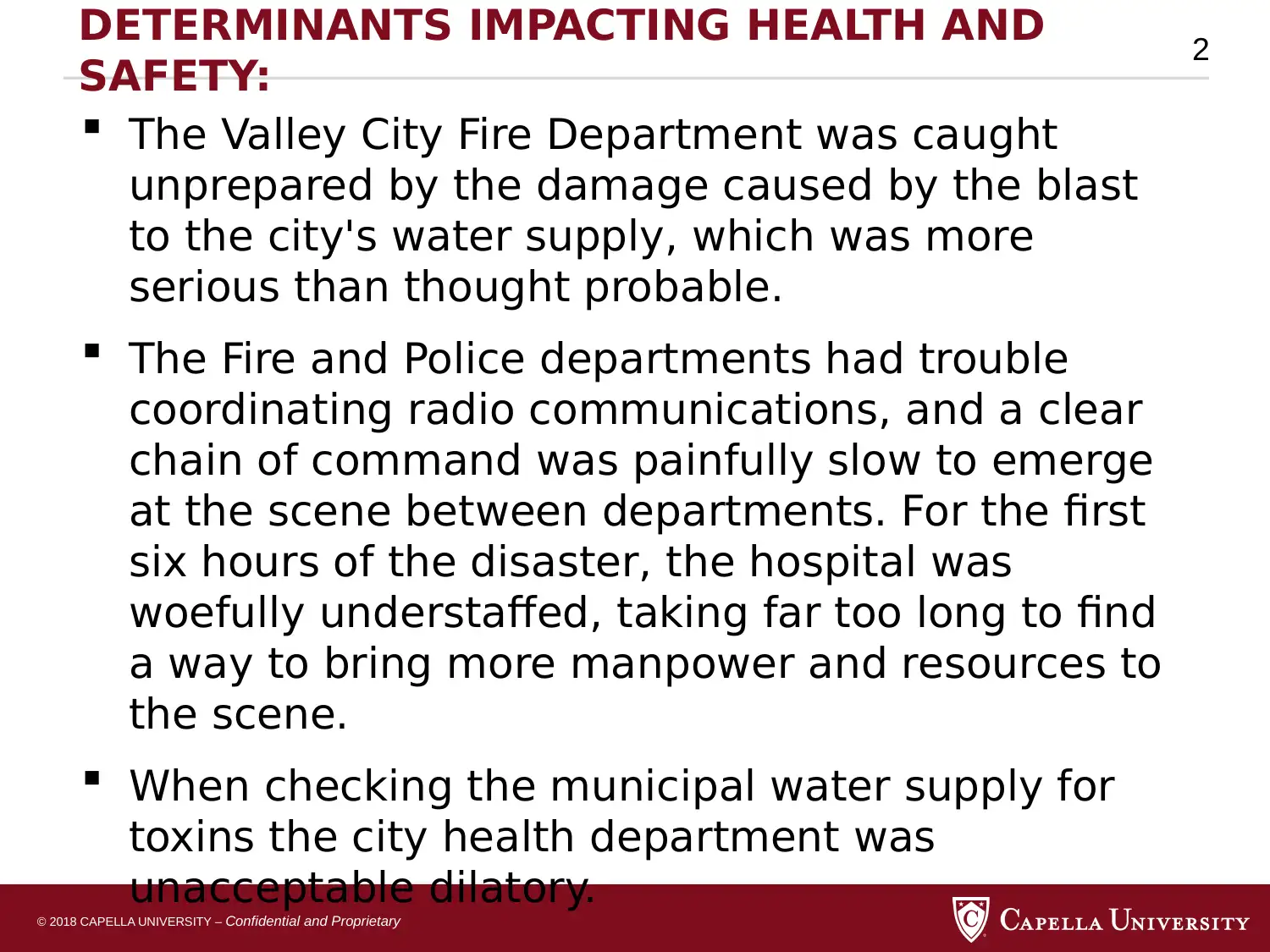
© 2018 CAPELLA UNIVERSITY – Confidential and Proprietary
2
DETERMINANTS IMPACTING HEALTH AND
SAFETY:
The Valley City Fire Department was caught
unprepared by the damage caused by the blast
to the city's water supply, which was more
serious than thought probable.
The Fire and Police departments had trouble
coordinating radio communications, and a clear
chain of command was painfully slow to emerge
at the scene between departments. For the first
six hours of the disaster, the hospital was
woefully understaffed, taking far too long to find
a way to bring more manpower and resources to
the scene.
When checking the municipal water supply for
toxins the city health department was
unacceptable dilatory.
2
DETERMINANTS IMPACTING HEALTH AND
SAFETY:
The Valley City Fire Department was caught
unprepared by the damage caused by the blast
to the city's water supply, which was more
serious than thought probable.
The Fire and Police departments had trouble
coordinating radio communications, and a clear
chain of command was painfully slow to emerge
at the scene between departments. For the first
six hours of the disaster, the hospital was
woefully understaffed, taking far too long to find
a way to bring more manpower and resources to
the scene.
When checking the municipal water supply for
toxins the city health department was
unacceptable dilatory.
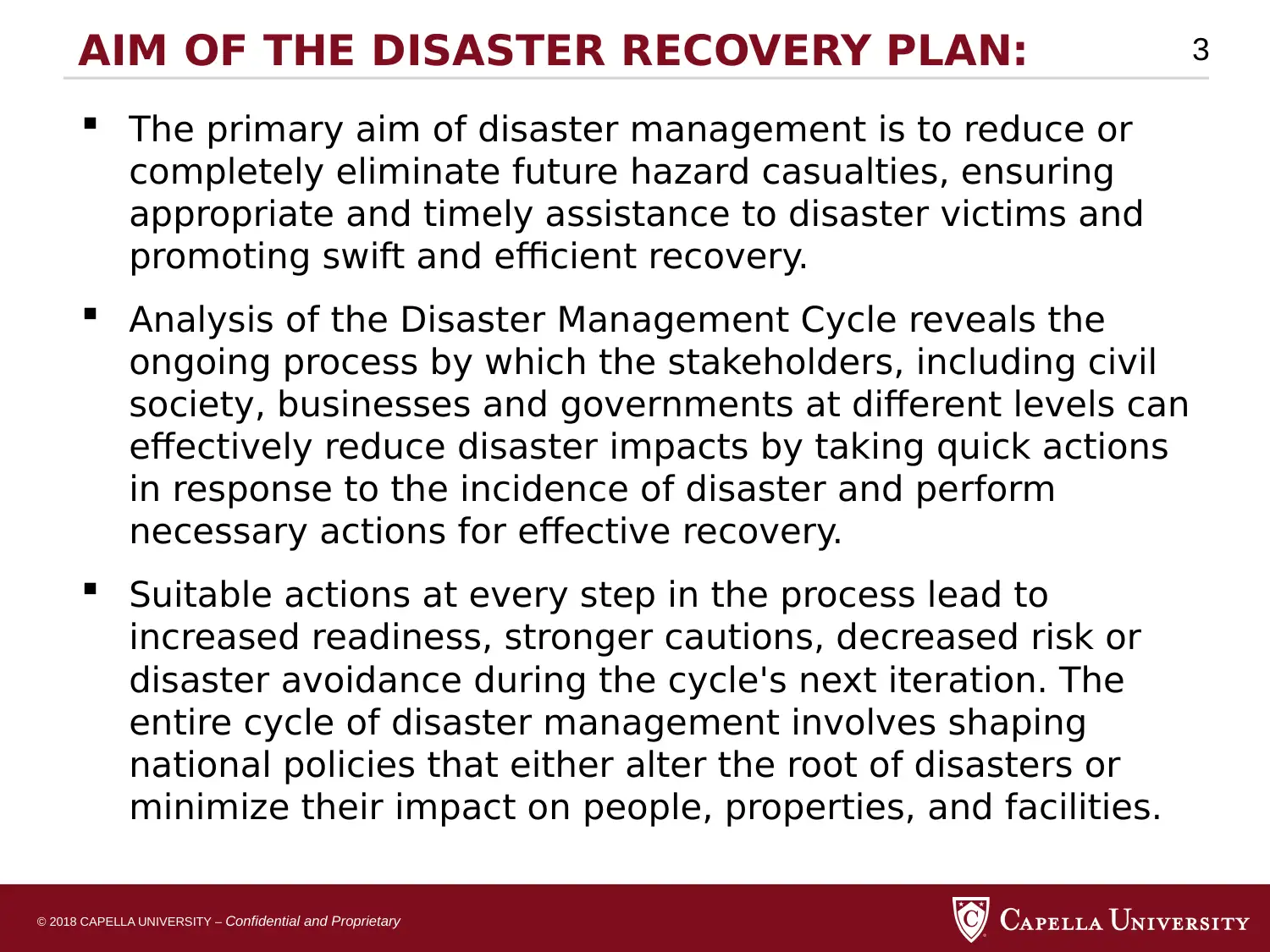
© 2018 CAPELLA UNIVERSITY – Confidential and Proprietary
3AIM OF THE DISASTER RECOVERY PLAN:
The primary aim of disaster management is to reduce or
completely eliminate future hazard casualties, ensuring
appropriate and timely assistance to disaster victims and
promoting swift and efficient recovery.
Analysis of the Disaster Management Cycle reveals the
ongoing process by which the stakeholders, including civil
society, businesses and governments at different levels can
effectively reduce disaster impacts by taking quick actions
in response to the incidence of disaster and perform
necessary actions for effective recovery.
Suitable actions at every step in the process lead to
increased readiness, stronger cautions, decreased risk or
disaster avoidance during the cycle's next iteration. The
entire cycle of disaster management involves shaping
national policies that either alter the root of disasters or
minimize their impact on people, properties, and facilities.
3AIM OF THE DISASTER RECOVERY PLAN:
The primary aim of disaster management is to reduce or
completely eliminate future hazard casualties, ensuring
appropriate and timely assistance to disaster victims and
promoting swift and efficient recovery.
Analysis of the Disaster Management Cycle reveals the
ongoing process by which the stakeholders, including civil
society, businesses and governments at different levels can
effectively reduce disaster impacts by taking quick actions
in response to the incidence of disaster and perform
necessary actions for effective recovery.
Suitable actions at every step in the process lead to
increased readiness, stronger cautions, decreased risk or
disaster avoidance during the cycle's next iteration. The
entire cycle of disaster management involves shaping
national policies that either alter the root of disasters or
minimize their impact on people, properties, and facilities.
⊘ This is a preview!⊘
Do you want full access?
Subscribe today to unlock all pages.

Trusted by 1+ million students worldwide
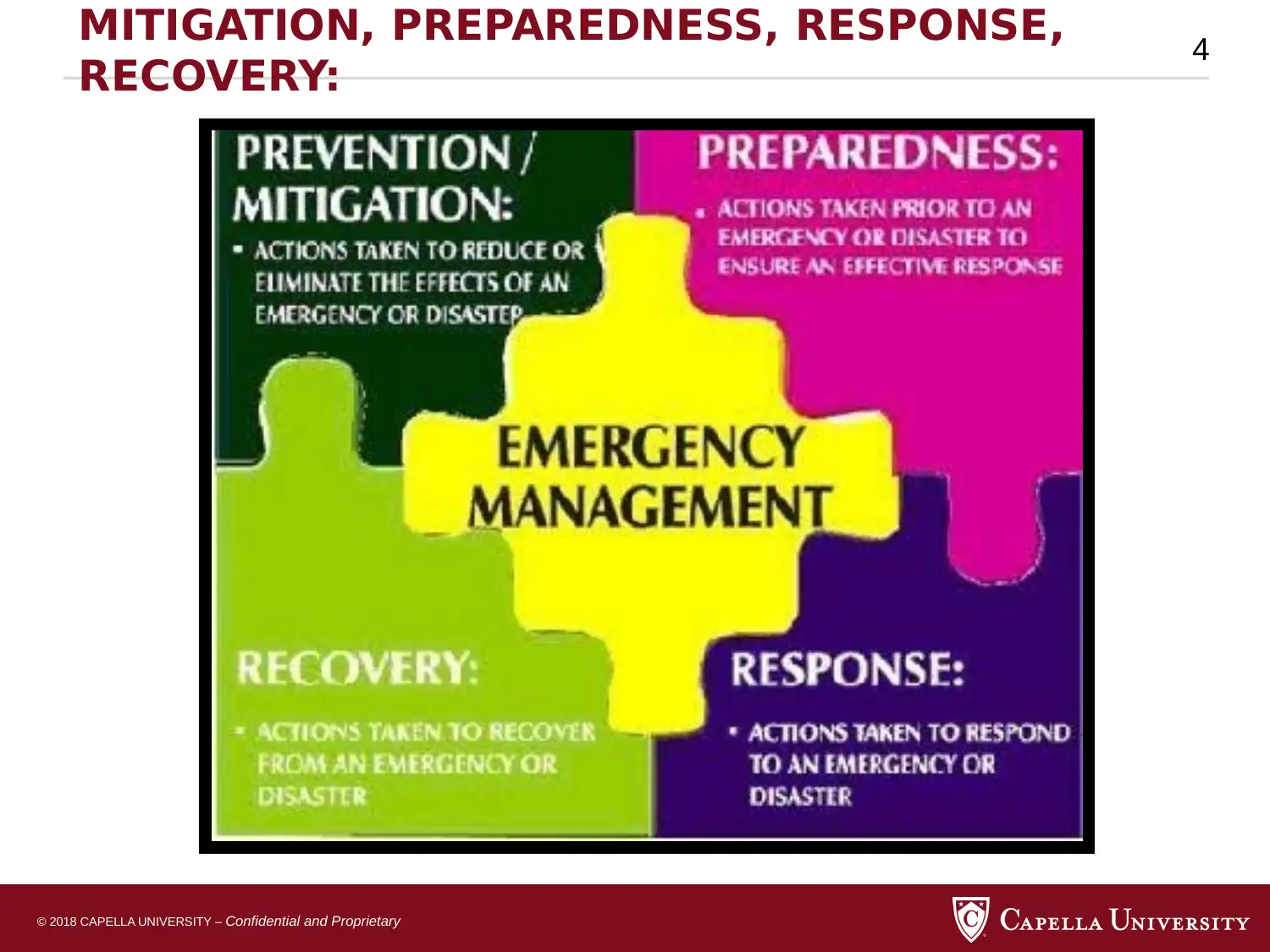
© 2018 CAPELLA UNIVERSITY – Confidential and Proprietary
4
MITIGATION, PREPAREDNESS, RESPONSE,
RECOVERY:
4
MITIGATION, PREPAREDNESS, RESPONSE,
RECOVERY:
Paraphrase This Document
Need a fresh take? Get an instant paraphrase of this document with our AI Paraphraser
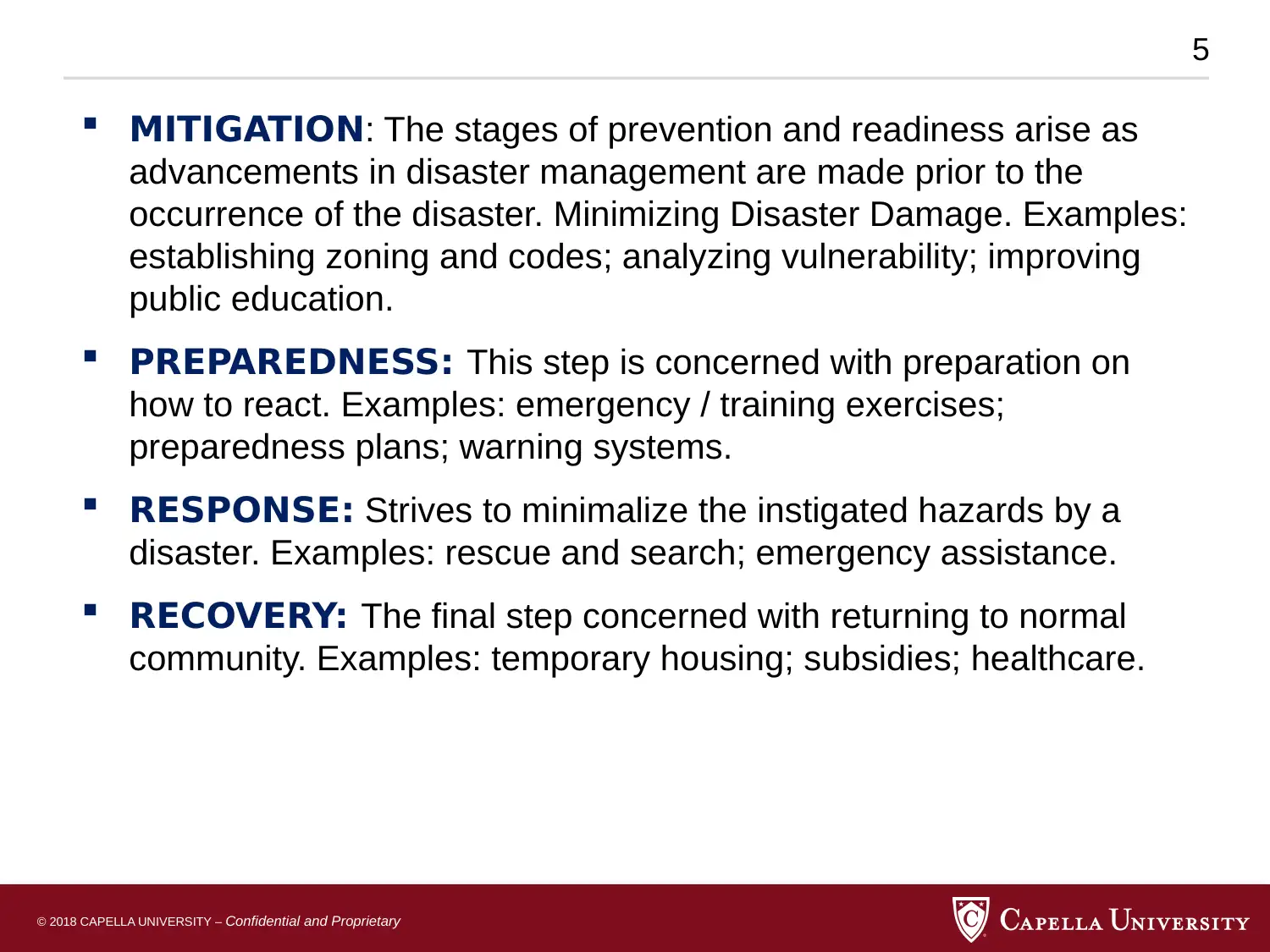
© 2018 CAPELLA UNIVERSITY – Confidential and Proprietary
5
MITIGATION: The stages of prevention and readiness arise as
advancements in disaster management are made prior to the
occurrence of the disaster. Minimizing Disaster Damage. Examples:
establishing zoning and codes; analyzing vulnerability; improving
public education.
PREPAREDNESS: This step is concerned with preparation on
how to react. Examples: emergency / training exercises;
preparedness plans; warning systems.
RESPONSE: Strives to minimalize the instigated hazards by a
disaster. Examples: rescue and search; emergency assistance.
RECOVERY: The final step concerned with returning to normal
community. Examples: temporary housing; subsidies; healthcare.
5
MITIGATION: The stages of prevention and readiness arise as
advancements in disaster management are made prior to the
occurrence of the disaster. Minimizing Disaster Damage. Examples:
establishing zoning and codes; analyzing vulnerability; improving
public education.
PREPAREDNESS: This step is concerned with preparation on
how to react. Examples: emergency / training exercises;
preparedness plans; warning systems.
RESPONSE: Strives to minimalize the instigated hazards by a
disaster. Examples: rescue and search; emergency assistance.
RECOVERY: The final step concerned with returning to normal
community. Examples: temporary housing; subsidies; healthcare.
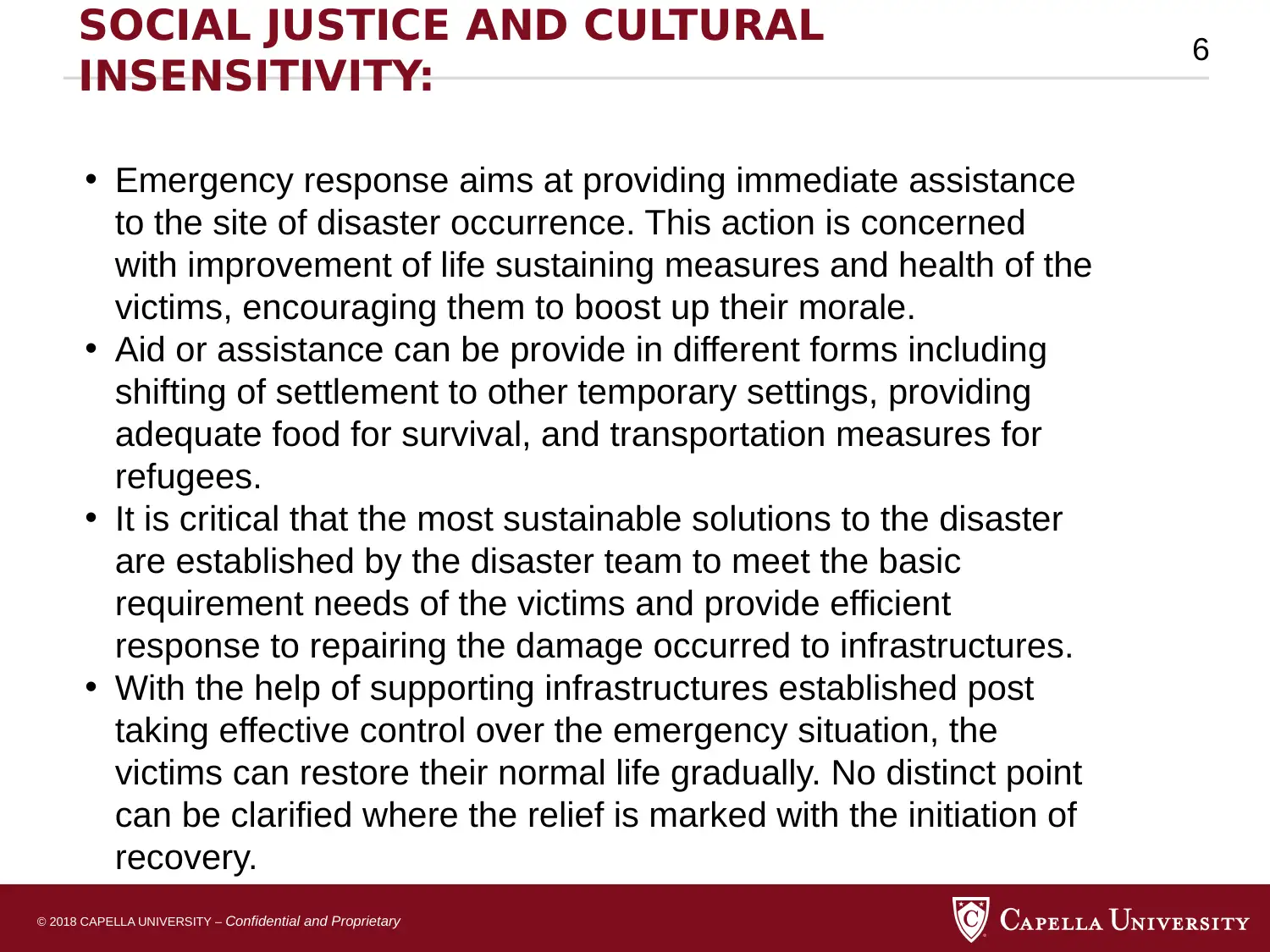
© 2018 CAPELLA UNIVERSITY – Confidential and Proprietary
6
SOCIAL JUSTICE AND CULTURAL
INSENSITIVITY:
• Emergency response aims at providing immediate assistance
to the site of disaster occurrence. This action is concerned
with improvement of life sustaining measures and health of the
victims, encouraging them to boost up their morale.
• Aid or assistance can be provide in different forms including
shifting of settlement to other temporary settings, providing
adequate food for survival, and transportation measures for
refugees.
• It is critical that the most sustainable solutions to the disaster
are established by the disaster team to meet the basic
requirement needs of the victims and provide efficient
response to repairing the damage occurred to infrastructures.
• With the help of supporting infrastructures established post
taking effective control over the emergency situation, the
victims can restore their normal life gradually. No distinct point
can be clarified where the relief is marked with the initiation of
recovery.
6
SOCIAL JUSTICE AND CULTURAL
INSENSITIVITY:
• Emergency response aims at providing immediate assistance
to the site of disaster occurrence. This action is concerned
with improvement of life sustaining measures and health of the
victims, encouraging them to boost up their morale.
• Aid or assistance can be provide in different forms including
shifting of settlement to other temporary settings, providing
adequate food for survival, and transportation measures for
refugees.
• It is critical that the most sustainable solutions to the disaster
are established by the disaster team to meet the basic
requirement needs of the victims and provide efficient
response to repairing the damage occurred to infrastructures.
• With the help of supporting infrastructures established post
taking effective control over the emergency situation, the
victims can restore their normal life gradually. No distinct point
can be clarified where the relief is marked with the initiation of
recovery.
⊘ This is a preview!⊘
Do you want full access?
Subscribe today to unlock all pages.

Trusted by 1+ million students worldwide
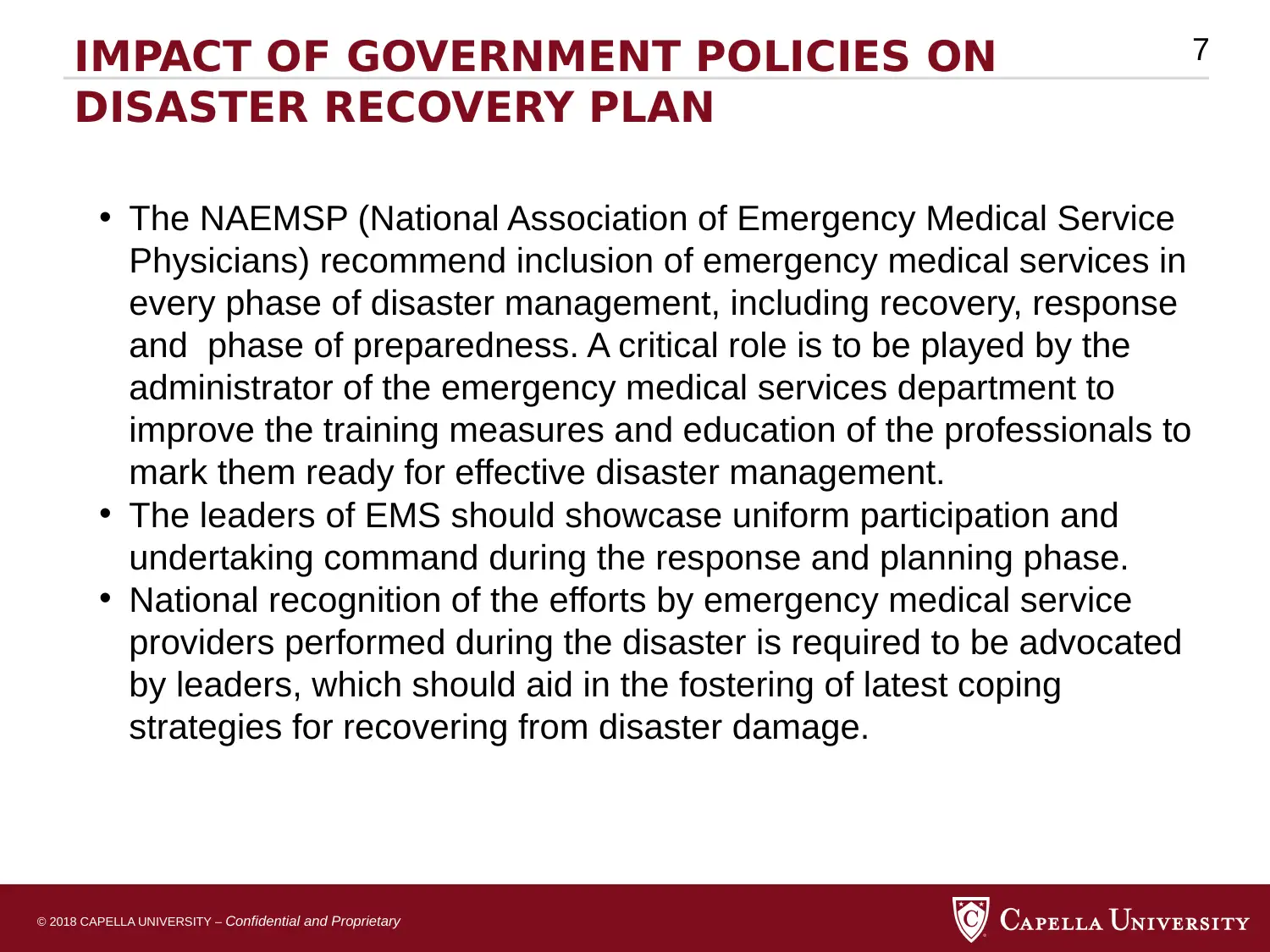
© 2018 CAPELLA UNIVERSITY – Confidential and Proprietary
7IMPACT OF GOVERNMENT POLICIES ON
DISASTER RECOVERY PLAN
• The NAEMSP (National Association of Emergency Medical Service
Physicians) recommend inclusion of emergency medical services in
every phase of disaster management, including recovery, response
and phase of preparedness. A critical role is to be played by the
administrator of the emergency medical services department to
improve the training measures and education of the professionals to
mark them ready for effective disaster management.
• The leaders of EMS should showcase uniform participation and
undertaking command during the response and planning phase.
• National recognition of the efforts by emergency medical service
providers performed during the disaster is required to be advocated
by leaders, which should aid in the fostering of latest coping
strategies for recovering from disaster damage.
7IMPACT OF GOVERNMENT POLICIES ON
DISASTER RECOVERY PLAN
• The NAEMSP (National Association of Emergency Medical Service
Physicians) recommend inclusion of emergency medical services in
every phase of disaster management, including recovery, response
and phase of preparedness. A critical role is to be played by the
administrator of the emergency medical services department to
improve the training measures and education of the professionals to
mark them ready for effective disaster management.
• The leaders of EMS should showcase uniform participation and
undertaking command during the response and planning phase.
• National recognition of the efforts by emergency medical service
providers performed during the disaster is required to be advocated
by leaders, which should aid in the fostering of latest coping
strategies for recovering from disaster damage.
Paraphrase This Document
Need a fresh take? Get an instant paraphrase of this document with our AI Paraphraser
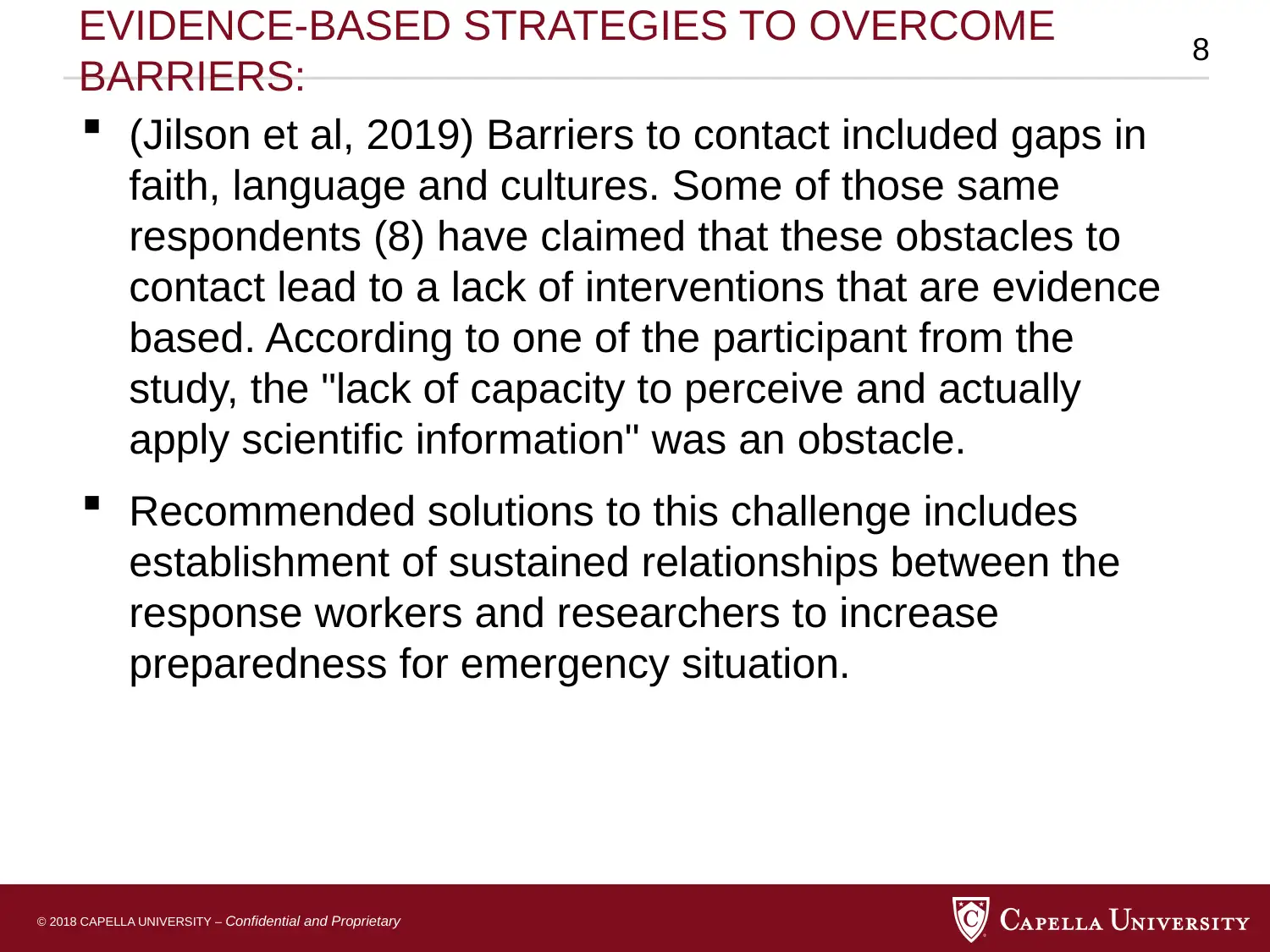
© 2018 CAPELLA UNIVERSITY – Confidential and Proprietary
8
EVIDENCE-BASED STRATEGIES TO OVERCOME
BARRIERS:
(Jilson et al, 2019) Barriers to contact included gaps in
faith, language and cultures. Some of those same
respondents (8) have claimed that these obstacles to
contact lead to a lack of interventions that are evidence
based. According to one of the participant from the
study, the "lack of capacity to perceive and actually
apply scientific information" was an obstacle.
Recommended solutions to this challenge includes
establishment of sustained relationships between the
response workers and researchers to increase
preparedness for emergency situation.
8
EVIDENCE-BASED STRATEGIES TO OVERCOME
BARRIERS:
(Jilson et al, 2019) Barriers to contact included gaps in
faith, language and cultures. Some of those same
respondents (8) have claimed that these obstacles to
contact lead to a lack of interventions that are evidence
based. According to one of the participant from the
study, the "lack of capacity to perceive and actually
apply scientific information" was an obstacle.
Recommended solutions to this challenge includes
establishment of sustained relationships between the
response workers and researchers to increase
preparedness for emergency situation.
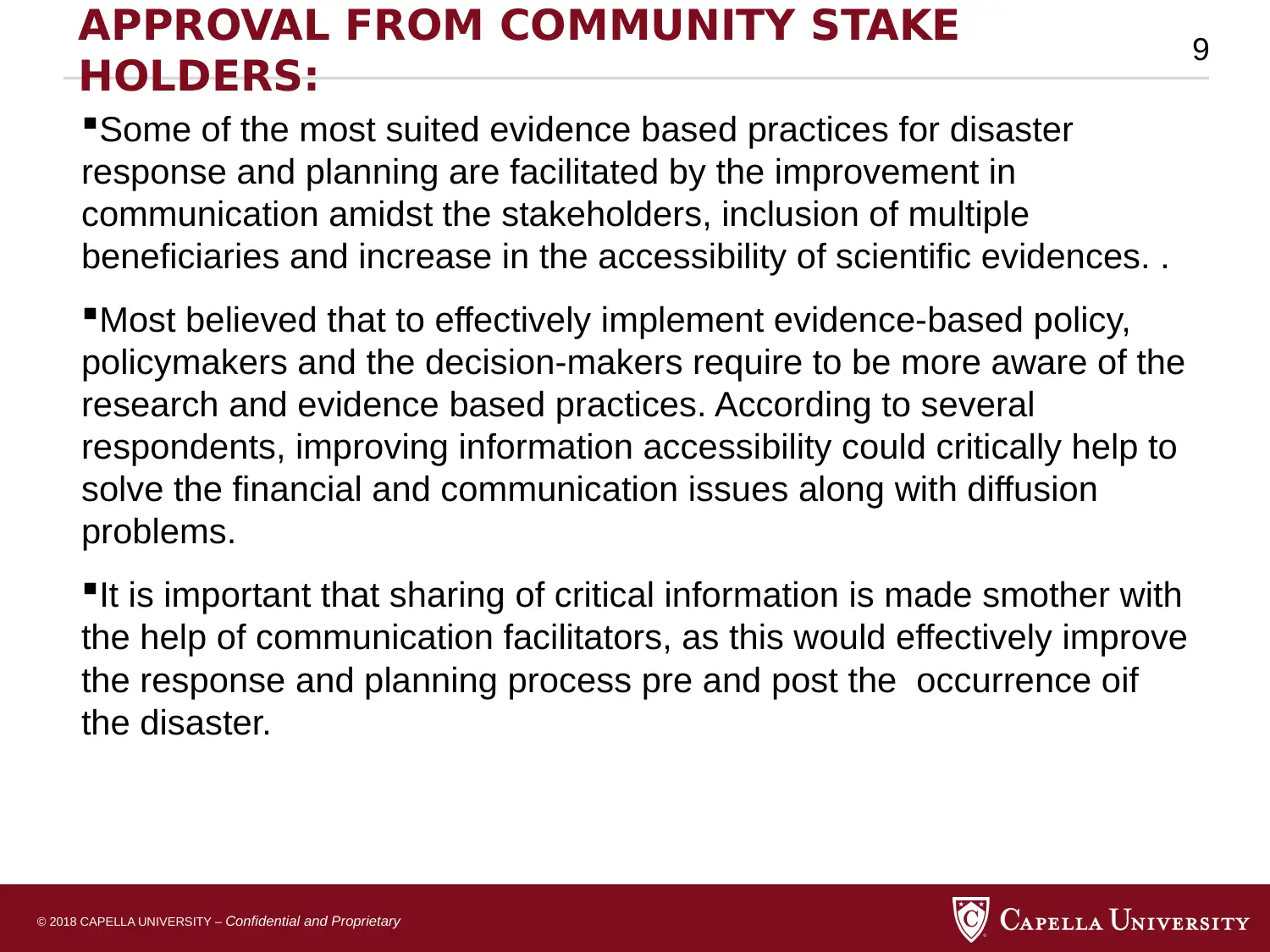
© 2018 CAPELLA UNIVERSITY – Confidential and Proprietary
9
APPROVAL FROM COMMUNITY STAKE
HOLDERS:
Some of the most suited evidence based practices for disaster
response and planning are facilitated by the improvement in
communication amidst the stakeholders, inclusion of multiple
beneficiaries and increase in the accessibility of scientific evidences. .
Most believed that to effectively implement evidence-based policy,
policymakers and the decision-makers require to be more aware of the
research and evidence based practices. According to several
respondents, improving information accessibility could critically help to
solve the financial and communication issues along with diffusion
problems.
It is important that sharing of critical information is made smother with
the help of communication facilitators, as this would effectively improve
the response and planning process pre and post the occurrence oif
the disaster.
9
APPROVAL FROM COMMUNITY STAKE
HOLDERS:
Some of the most suited evidence based practices for disaster
response and planning are facilitated by the improvement in
communication amidst the stakeholders, inclusion of multiple
beneficiaries and increase in the accessibility of scientific evidences. .
Most believed that to effectively implement evidence-based policy,
policymakers and the decision-makers require to be more aware of the
research and evidence based practices. According to several
respondents, improving information accessibility could critically help to
solve the financial and communication issues along with diffusion
problems.
It is important that sharing of critical information is made smother with
the help of communication facilitators, as this would effectively improve
the response and planning process pre and post the occurrence oif
the disaster.
⊘ This is a preview!⊘
Do you want full access?
Subscribe today to unlock all pages.

Trusted by 1+ million students worldwide
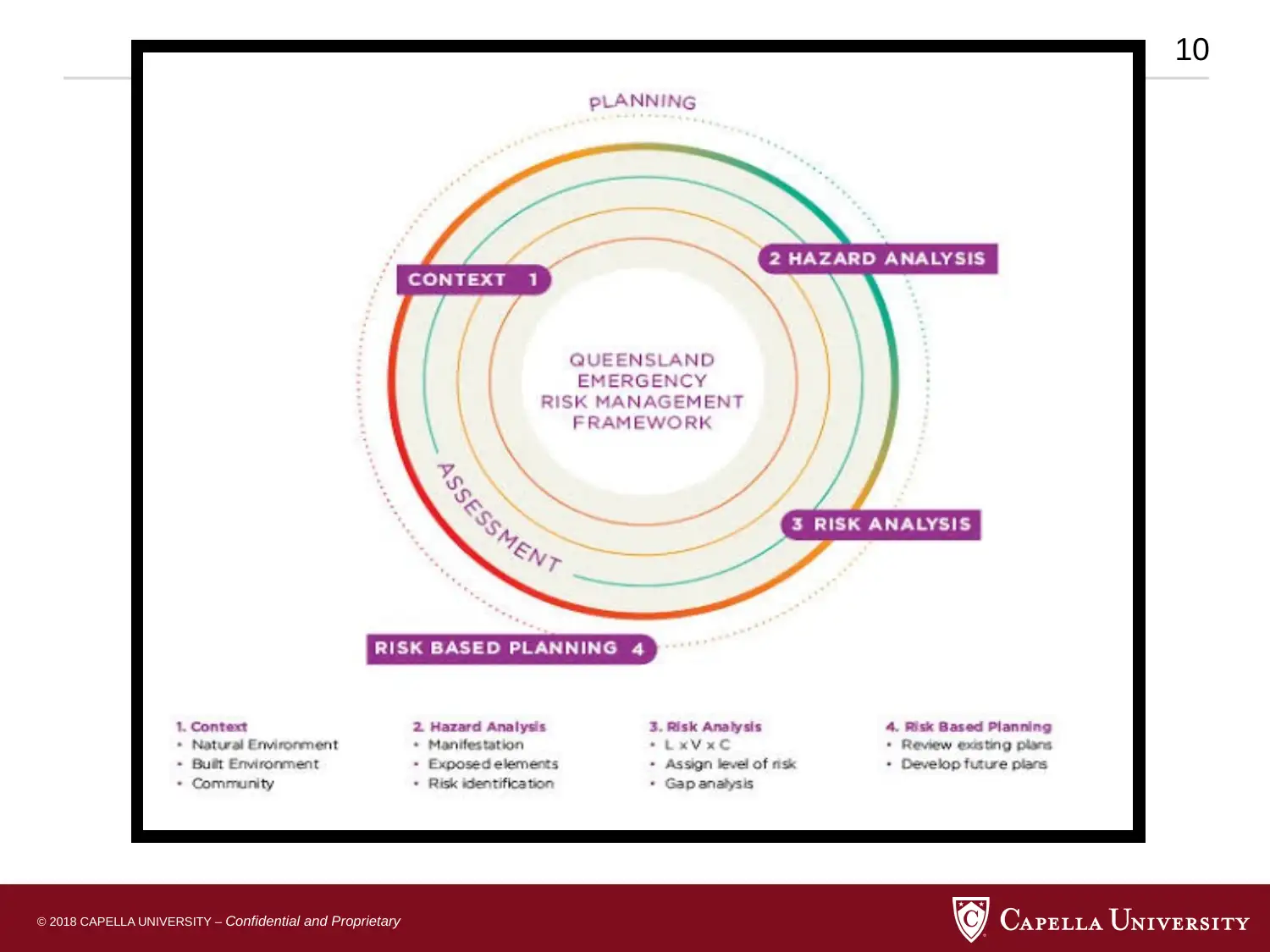
© 2018 CAPELLA UNIVERSITY – Confidential and Proprietary
10
10
Paraphrase This Document
Need a fresh take? Get an instant paraphrase of this document with our AI Paraphraser
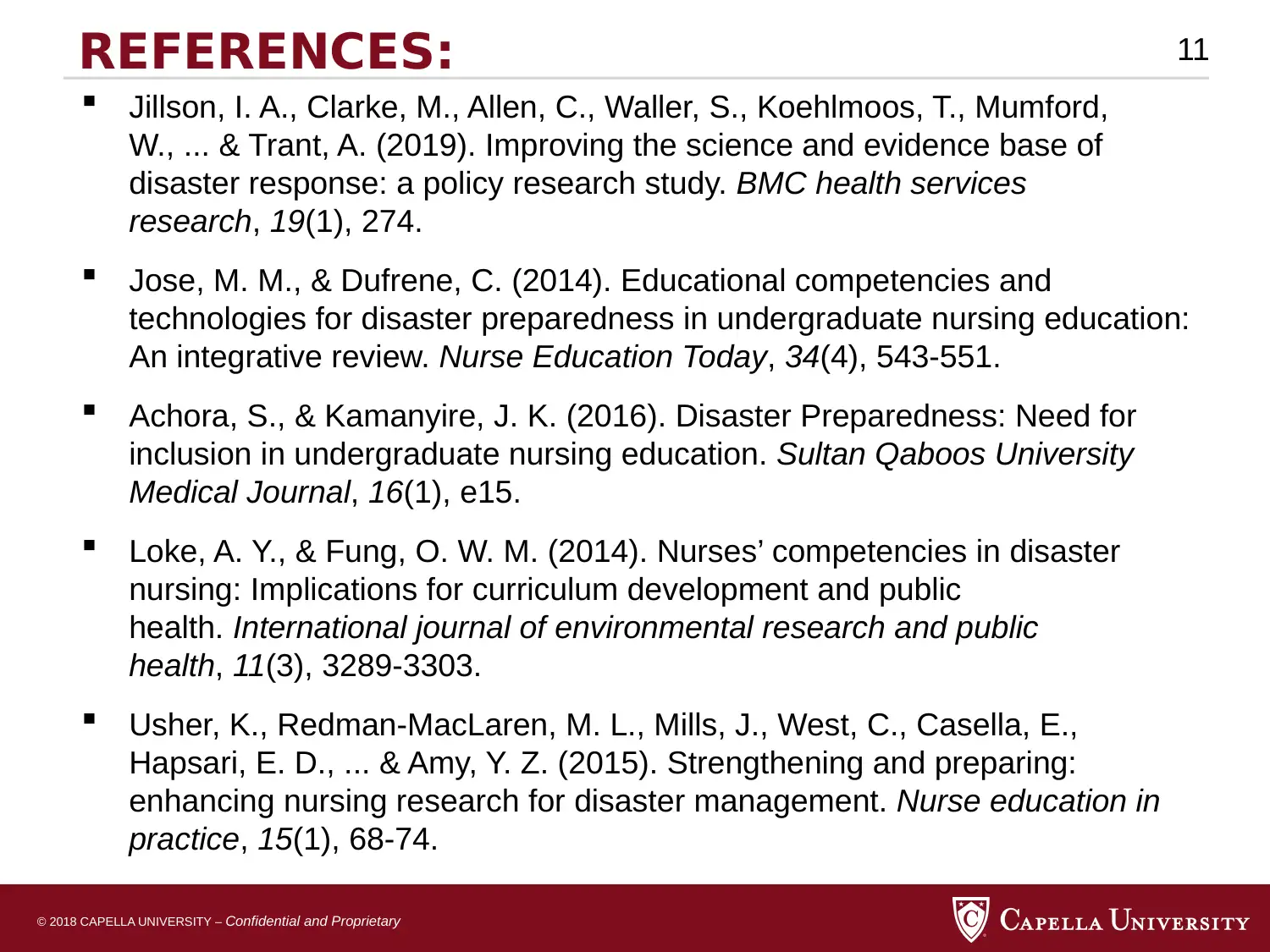
© 2018 CAPELLA UNIVERSITY – Confidential and Proprietary
11REFERENCES:
Jillson, I. A., Clarke, M., Allen, C., Waller, S., Koehlmoos, T., Mumford,
W., ... & Trant, A. (2019). Improving the science and evidence base of
disaster response: a policy research study. BMC health services
research, 19(1), 274.
Jose, M. M., & Dufrene, C. (2014). Educational competencies and
technologies for disaster preparedness in undergraduate nursing education:
An integrative review. Nurse Education Today, 34(4), 543-551.
Achora, S., & Kamanyire, J. K. (2016). Disaster Preparedness: Need for
inclusion in undergraduate nursing education. Sultan Qaboos University
Medical Journal, 16(1), e15.
Loke, A. Y., & Fung, O. W. M. (2014). Nurses’ competencies in disaster
nursing: Implications for curriculum development and public
health. International journal of environmental research and public
health, 11(3), 3289-3303.
Usher, K., Redman-MacLaren, M. L., Mills, J., West, C., Casella, E.,
Hapsari, E. D., ... & Amy, Y. Z. (2015). Strengthening and preparing:
enhancing nursing research for disaster management. Nurse education in
practice, 15(1), 68-74.
11REFERENCES:
Jillson, I. A., Clarke, M., Allen, C., Waller, S., Koehlmoos, T., Mumford,
W., ... & Trant, A. (2019). Improving the science and evidence base of
disaster response: a policy research study. BMC health services
research, 19(1), 274.
Jose, M. M., & Dufrene, C. (2014). Educational competencies and
technologies for disaster preparedness in undergraduate nursing education:
An integrative review. Nurse Education Today, 34(4), 543-551.
Achora, S., & Kamanyire, J. K. (2016). Disaster Preparedness: Need for
inclusion in undergraduate nursing education. Sultan Qaboos University
Medical Journal, 16(1), e15.
Loke, A. Y., & Fung, O. W. M. (2014). Nurses’ competencies in disaster
nursing: Implications for curriculum development and public
health. International journal of environmental research and public
health, 11(3), 3289-3303.
Usher, K., Redman-MacLaren, M. L., Mills, J., West, C., Casella, E.,
Hapsari, E. D., ... & Amy, Y. Z. (2015). Strengthening and preparing:
enhancing nursing research for disaster management. Nurse education in
practice, 15(1), 68-74.
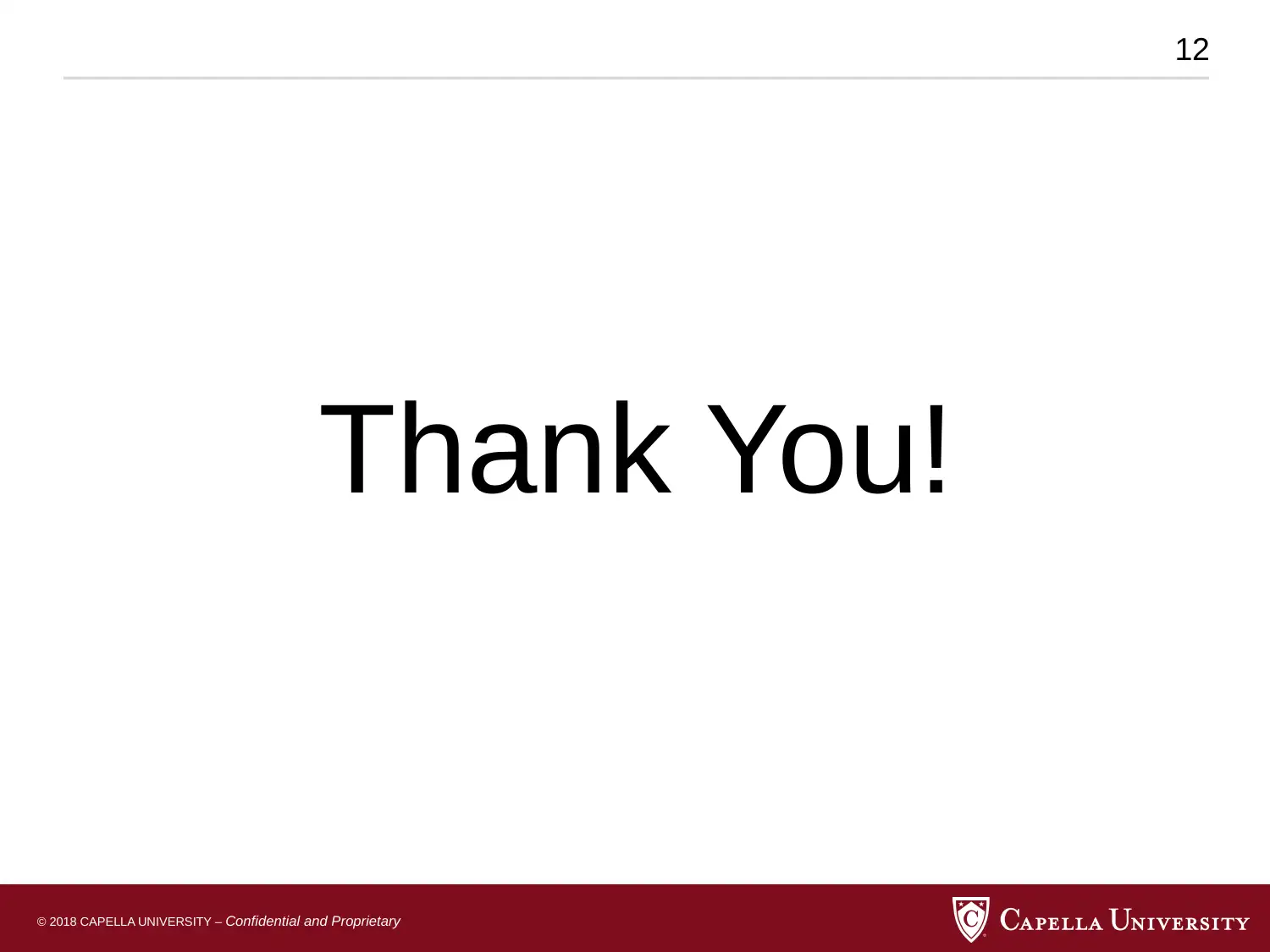
© 2018 CAPELLA UNIVERSITY – Confidential and Proprietary
12
Thank You!
12
Thank You!
⊘ This is a preview!⊘
Do you want full access?
Subscribe today to unlock all pages.

Trusted by 1+ million students worldwide
1 out of 12
Related Documents
Your All-in-One AI-Powered Toolkit for Academic Success.
+13062052269
info@desklib.com
Available 24*7 on WhatsApp / Email
![[object Object]](/_next/static/media/star-bottom.7253800d.svg)
Unlock your academic potential
Copyright © 2020–2025 A2Z Services. All Rights Reserved. Developed and managed by ZUCOL.




